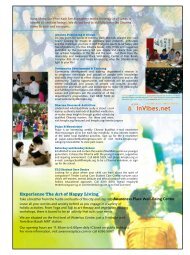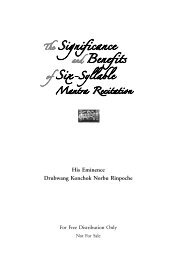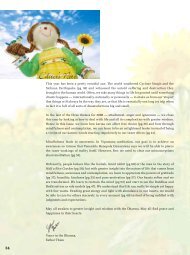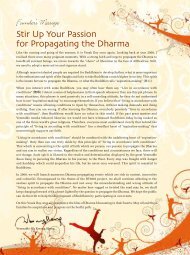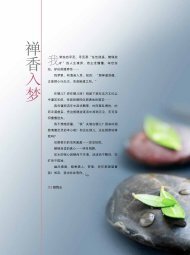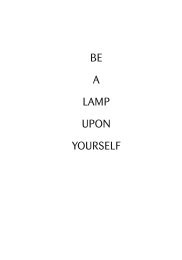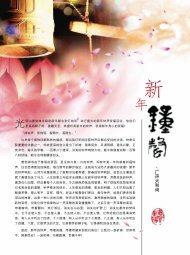Editor's Note - Dharma Resources - Kong Meng San Phor Kark See ...
Editor's Note - Dharma Resources - Kong Meng San Phor Kark See ...
Editor's Note - Dharma Resources - Kong Meng San Phor Kark See ...
Create successful ePaper yourself
Turn your PDF publications into a flip-book with our unique Google optimized e-Paper software.
Glossary<br />
awaken<br />
Amitabha (Amida, Amita, Amitayus): Amitabha is the most commonly<br />
used name for the Buddha of Infinite Light and Infinite Life. A transhistorical<br />
Buddha venerated by all Mahayana schools particularly, Pure Land. Presides<br />
over the Western Pure Land (Land of Ultimate Bliss), where anyone can be<br />
reborn through utterly sincere recitation of His name, particularly at the<br />
time of death Amitabha Sutra is one of the three cardinal Pure Land Sutras.<br />
Attachment: Attachments are what keep us turning on the wheel of<br />
rebirth. In the Four Noble truths, Buddha Shakyamuni taught that<br />
attachment to self is the root cause of suffering: From craving [attachment]<br />
springs grief, from craving springs fear; For him who is wholly free from<br />
craving, there is no grief, much less fear. (Dhammapada) Becoming<br />
enlightened is nothing other than severing all our attachments. What<br />
is meant by “attachment” It is the investing of mental or emotional<br />
energy in an “object”. We can become attached to people, things,<br />
experiential states, and our own thoughts and preconceptions. In<br />
Buddhist teachings attachments are usually divided into two general<br />
categories: attachments to self and attachments to dharmas. For the<br />
seasoned practitioner, even the <strong>Dharma</strong> must not become an attachment.<br />
Aversion: Exaggerated wanting to be separated from someone or something.<br />
Bhikkhu: A fully ordained male Buddhist monastic, who lived by the<br />
vinaya’s framework of monastic discipline. Their lifestyle is shaped so as<br />
to support their spiritual practice, to live a simple and meditative life, and<br />
attain Nirvana. Called bhiksu in <strong>San</strong>skrit.<br />
Bodhisattva: One who aspires to save all beings from suffering, while<br />
saving oneself.<br />
Buddha: An aspect of the Triple Gem - The Awakened or Enlightened<br />
One. A Buddha is one who has attained liberation from all suffering,<br />
attaining True Happiness, Perfect Wisdom and Perfect Compassion,<br />
among all other virtues for the sake of helping all sentient beings. “The<br />
Buddha” refers to the historical Shakyamuni or Gautama Buddha, who is<br />
the founder of Buddhism in our world.<br />
Buddha-<strong>Dharma</strong>: Buddhists do not call the teachings of the Buddha,<br />
which they follow, Buddhism; they call them Buddha-<strong>Dharma</strong>, the<br />
<strong>Dharma</strong> of the Buddhas.<br />
Buddha-nature: The original nature present in all beings which<br />
when realised leads to enlightenment. It is often called the essence of<br />
Buddhahood or enlightened essence.<br />
Compassion: The quality that makes us aspire to help others with no<br />
selfish intention; the ending of selfishness.<br />
Dedication of merits: Sharing one’s own merits and virtues with others.<br />
Defilements: Our negative qualities - chiefly Greed (Craving), Hatred<br />
(Aversion) and Ignorance (Delusion).<br />
Delusion: The quality of lacking Wisdom, not knowing the reality of all<br />
things. Same as ‘ignorance’.<br />
<strong>Dharma</strong>: An aspect of the Triple Gem - the teachings of the Buddha or the<br />
general teachings of Buddhism. ‘Dhamma’ in Pali language.<br />
Dhutanga: Means ‘ascetic’. A dhutanga monk is one who keeps some of<br />
the thirteen ascetic practices allowed by the Buddha. Dhutanga monks<br />
traditionally spend time travelling (often on foot) in search of quiet places<br />
for meditation, other teachers, or simply as a practice in itself.<br />
Eight precepts: Include the five precepts and add three more: Refrain<br />
from (6) using cosmetics or personal adornments and watching songdance<br />
entertainments; (7) sleeping on a luxurious bed; and (8) eating<br />
food after lunch. Lay Buddhists who have accepted the eight precepts<br />
need to observe them periodically for one day.<br />
Emptiness: The truth of all mind and matter constantly changing, thus<br />
being empty of any fixed self.<br />
Enlightenment: The realisation of the reality of all things as they truly<br />
are. True Happiness is the result.<br />
Five Precepts: The basic guidelines of moral conduct - not killing,<br />
not stealing, not having sexual misconduct, not lying and not taking<br />
intoxicants.<br />
Four Noble Truths: 1. Life is full of dissatisfactory experiences - ageing,<br />
sickness, separation, death etc 2. Causes of dissatisfactory experiences<br />
- craving, aversion and ignorance 3. Life can be without dissatisfaction<br />
- by attaining Enlightenment or Nirvana 4. The path leading to the end of<br />
dissatisfactions - The Noble Eightfold path.<br />
Four Opponent Powers: Having regret, making a determination not to do<br />
the action again, taking refuge in the Triple Gem and generating an altruistic<br />
attitude towards others, lastly by doing an actual remedial practice such<br />
as chanting Buddha’s names, mantras or sutras, meditating, prostrating,<br />
making offerings, listening to teachings or reading a <strong>Dharma</strong> book.<br />
Gampopa: One of the main lineage holders of the Kagyu lineage in Tibet<br />
(1079-1153 C.E.). A student of Milarepa, he established the first Kagyu<br />
monastic monastery and is known for writing the Jewel Ornament of<br />
Liberation.<br />
Guanyin: Avalokiteshvara Bodhisattva; the Bodhisattva who personifies<br />
the perfect Compassion of all Buddhas, who hears and heeds the<br />
cries of the world. Also known as Chenrezig in Vajrayana tradition.<br />
Ignorance: <strong>See</strong> ‘Delusion’<br />
Impermanence: All compounded things are constantly changing, as a<br />
result or effect of changing causes and conditions. All living and nonliving<br />
elements are thus subject to decay and renewal.<br />
Initiation: Empowerment. Bestowal of permission and a special potential<br />
power to practise a specific part of Tantra, given by a tantric guru by means<br />
of a ritual.<br />
Karma: The moral law of cause and effect which states that what we<br />
experience is the result of what we had done, that what we do will result<br />
in what we will experience. Kamma in Pali language<br />
Koan: A brief anecdote recording an exchange between master and disciple<br />
or a master’s enlightenment experience. Koans are used to bring a student<br />
to realisation or to help clarify his enlightenment.<br />
Liberation: State after removing the defilements and karma which cause<br />
uncontrolled rebirth in cyclic existence.<br />
Loving-kindness: The quality which makes us wish for the happiness<br />
and well-being of others. ‘Metta’ in Pali language.<br />
Mahayana: The dominant Buddhist tradition of East Asia that emphasises<br />
on the Bodhisattva ideal.<br />
Mantra: Prescribed syllables (in <strong>San</strong>skrit) to protect the mind from<br />
defilements. They express the essence of specific energies. Recitation of<br />
mantras is always done with specific visualisations.<br />
Meditation: A practice to habituate ourselves to positive and realistic<br />
states of mind.<br />
Merits: Blessings, positive potential. Imprints on the mindstream of<br />
positive actions, leading to future happiness.<br />
Mindfulness: An aspect of the ‘Noble Eightfold Path’ - the quality that<br />
enables us to remember, and keep our awareness and attention on what is<br />
beneficial to one and all in terms of thoughts, speech and actions.<br />
Mindstream: Continuity of the mind, stream of moments of consciousness<br />
proceeding endlessly in a lifetime, between lifetimes, from lifetime to<br />
lifetime.<br />
Nirvana: Nirvana is a <strong>San</strong>skrit term that is interpreted in various ways:<br />
1)cessation, or extinction, referring to the elimination of the afflictions<br />
at the time of enlightenment, 2) freedom from desire; and 3) no longer<br />
either coming into being or ceasing to be. ‘Nibbana’ in Pali language.<br />
Noble Eightfold Path: A systematic and complete formula to rid<br />
dissatisfaction and attain true happiness and peace by following Perfect<br />
Speech, Perfect Action, Perfect Livelihood, Perfect Effort, Perfect<br />
Mindfulness, Perfect Meditation, Perfect Understanding, Perfect Thought<br />
(pls read Be A Lamp Upon Yourself published by KMSPKS for detailed info).<br />
Paramita/Perfection: Refers to the six practices, the perfection of which<br />
ferries one beyond the sea of suffering and mortality to Nirvana.<br />
Positive potential: <strong>See</strong> ‘Merits’<br />
Pureland: A world without defilements created by a Buddha out of<br />
Compassion, for sentient beings to seek birth in, to perfect the practice<br />
of the <strong>Dharma</strong>. The best known being Sukhavati Pureland created by<br />
Amitabha Buddha.<br />
Rebirth: The continual cycle of birth and death.<br />
Refuge: In the Buddhist context to take refuge means to accept the Buddha<br />
and the Buddhist teachings as the path one wants to takes.<br />
Renunciation: Determination to be free from all problems and suffering (of<br />
cyclic existence), not longer having attachment to the pleasures of cyclic<br />
existence which lead to more suffering and defilements. It is inner wisdom.<br />
Samsara: This world of rebirth and suffering. Also known as Saha<br />
world<br />
<strong>San</strong>gha: An aspect of the Triple Gem - the holy community of monks<br />
and nuns.<br />
Sentient Beings: Living beings with feelings in the six Samsara realms of<br />
hells, hungry ghosts, animals, humans, demi-gods and gods.<br />
Six Realms of Existence: Also called the Six Paths of Rebirth, it refers to<br />
the six categories of living beings who are not enlightened. They are 1)<br />
Gods, 2) Humans, 3) Asuras, 4) Animals, 5) Ghosts, 6) Hell-dwellers. The<br />
particular category that one finds oneself reborn in depends upon one’s<br />
karma at the time of rebirth.<br />
Suffering: The physical and mental feeling of dissatisfaction.<br />
Sutra (s): The recorded teachings of the Buddha. Spelt as Sutta in Pali<br />
language.<br />
Tantric vows: Also known as samaya, it is a set of vows or precepts given to<br />
initiates of an esoteric Vajrayana Buddhist order as part of the empowerment<br />
or initiation that creates a bond between the guru and disciple.<br />
Triple Gem: The Buddha, the <strong>Dharma</strong> and the <strong>San</strong>gha. Also known as<br />
the Three Jewels.<br />
Venerable: An honorific addressing of a member of the <strong>San</strong>gha.<br />
Zen: A school of Buddhism. Also known as Chan.<br />
64



